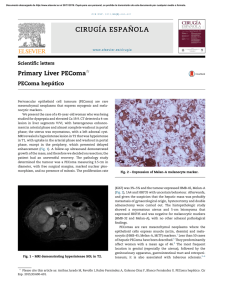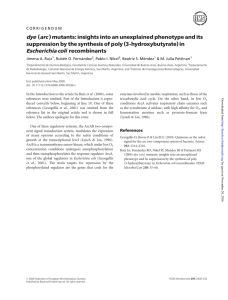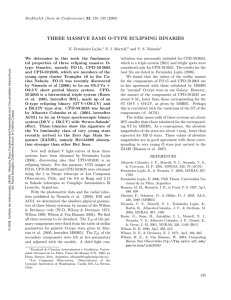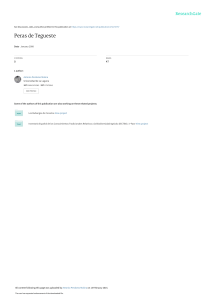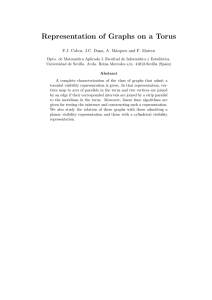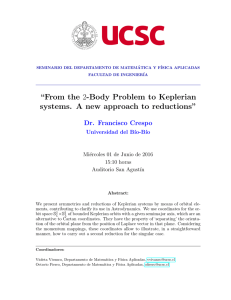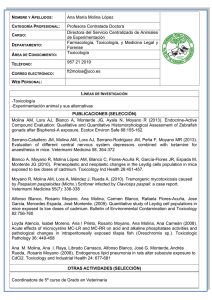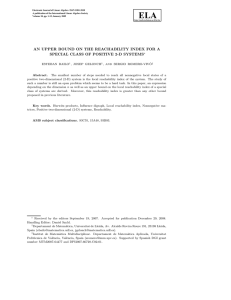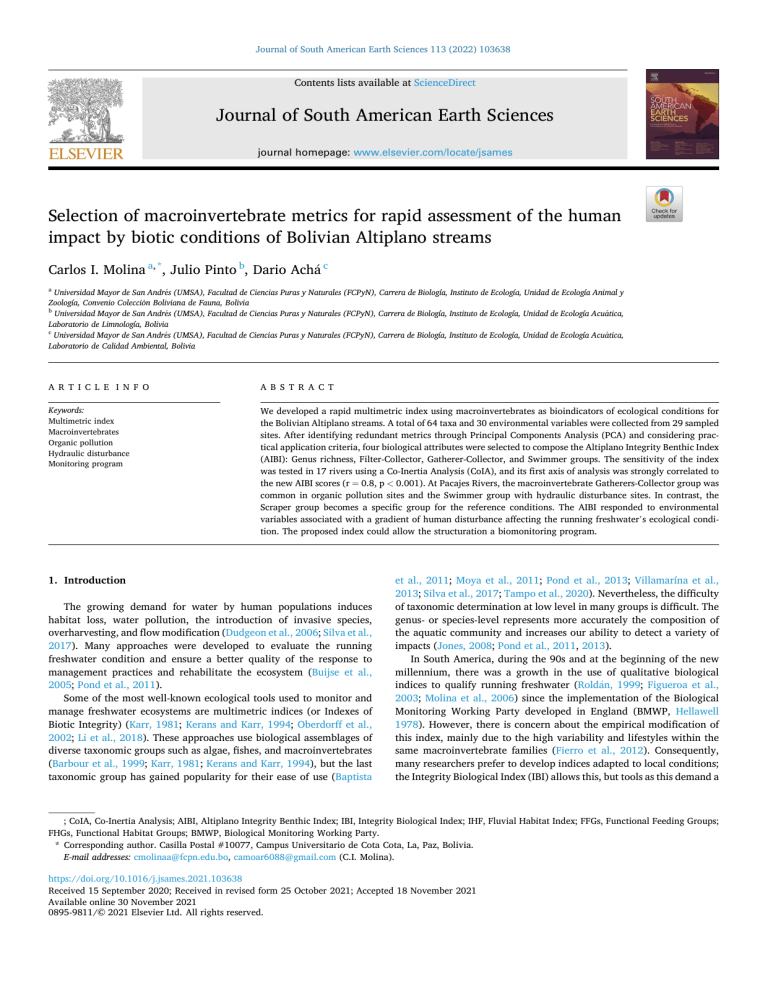
Journal of South American Earth Sciences 113 (2022) 103638 Contents lists available at ScienceDirect Journal of South American Earth Sciences journal homepage: www.elsevier.com/locate/jsames Selection of macroinvertebrate metrics for rapid assessment of the human impact by biotic conditions of Bolivian Altiplano streams Carlos I. Molina a, *, Julio Pinto b, Dario Achá c a Universidad Mayor de San Andrés (UMSA), Facultad de Ciencias Puras y Naturales (FCPyN), Carrera de Biología, Instituto de Ecología, Unidad de Ecología Animal y Zoología, Convenio Colección Boliviana de Fauna, Bolivia b Universidad Mayor de San Andrés (UMSA), Facultad de Ciencias Puras y Naturales (FCPyN), Carrera de Biología, Instituto de Ecología, Unidad de Ecología Acuática, Laboratorio de Limnología, Bolivia c Universidad Mayor de San Andrés (UMSA), Facultad de Ciencias Puras y Naturales (FCPyN), Carrera de Biología, Instituto de Ecología, Unidad de Ecología Acuática, Laboratorio de Calidad Ambiental, Bolivia A R T I C L E I N F O A B S T R A C T Keywords: Multimetric index Macroinvertebrates Organic pollution Hydraulic disturbance Monitoring program We developed a rapid multimetric index using macroinvertebrates as bioindicators of ecological conditions for the Bolivian Altiplano streams. A total of 64 taxa and 30 environmental variables were collected from 29 sampled sites. After identifying redundant metrics through Principal Components Analysis (PCA) and considering prac­ tical application criteria, four biological attributes were selected to compose the Altiplano Integrity Benthic Index (AIBI): Genus richness, Filter-Collector, Gatherer-Collector, and Swimmer groups. The sensitivity of the index was tested in 17 rivers using a Co-Inertia Analysis (CoIA), and its first axis of analysis was strongly correlated to the new AIBI scores (r = 0.8, p < 0.001). At Pacajes Rivers, the macroinvertebrate Gatherers-Collector group was common in organic pollution sites and the Swimmer group with hydraulic disturbance sites. In contrast, the Scraper group becomes a specific group for the reference conditions. The AIBI responded to environmental variables associated with a gradient of human disturbance affecting the running freshwater’s ecological condi­ tion. The proposed index could allow the structuration a biomonitoring program. 1. Introduction The growing demand for water by human populations induces habitat loss, water pollution, the introduction of invasive species, overharvesting, and flow modification (Dudgeon et al., 2006; Silva et al., 2017). Many approaches were developed to evaluate the running freshwater condition and ensure a better quality of the response to management practices and rehabilitate the ecosystem (Buijse et al., 2005; Pond et al., 2011). Some of the most well-known ecological tools used to monitor and manage freshwater ecosystems are multimetric indices (or Indexes of Biotic Integrity) (Karr, 1981; Kerans and Karr, 1994; Oberdorff et al., 2002; Li et al., 2018). These approaches use biological assemblages of diverse taxonomic groups such as algae, fishes, and macroinvertebrates (Barbour et al., 1999; Karr, 1981; Kerans and Karr, 1994), but the last taxonomic group has gained popularity for their ease of use (Baptista et al., 2011; Moya et al., 2011; Pond et al., 2013; Villamarína et al., 2013; Silva et al., 2017; Tampo et al., 2020). Nevertheless, the difficulty of taxonomic determination at low level in many groups is difficult. The genus- or species-level represents more accurately the composition of the aquatic community and increases our ability to detect a variety of impacts (Jones, 2008; Pond et al., 2011, 2013). In South America, during the 90s and at the beginning of the new millennium, there was a growth in the use of qualitative biological indices to qualify running freshwater (Roldán, 1999; Figueroa et al., 2003; Molina et al., 2006) since the implementation of the Biological Monitoring Working Party developed in England (BMWP, Hellawell 1978). However, there is concern about the empirical modification of this index, mainly due to the high variability and lifestyles within the same macroinvertebrate families (Fierro et al., 2012). Consequently, many researchers prefer to develop indices adapted to local conditions; the Integrity Biological Index (IBI) allows this, but tools as this demand a ; CoIA, Co-Inertia Analysis; AIBI, Altiplano Integrity Benthic Index; IBI, Integrity Biological Index; IHF, Fluvial Habitat Index; FFGs, Functional Feeding Groups; FHGs, Functional Habitat Groups; BMWP, Biological Monitoring Working Party. * Corresponding author. Casilla Postal #10077, Campus Universitario de Cota Cota, La, Paz, Bolivia. E-mail addresses: [email protected], [email protected] (C.I. Molina). https://doi.org/10.1016/j.jsames.2021.103638 Received 15 September 2020; Received in revised form 25 October 2021; Accepted 18 November 2021 Available online 30 November 2021 0895-9811/© 2021 Elsevier Ltd. All rights reserved. Journal of South American Earth Sciences 113 (2022) 103638 C.I. Molina et al. lot of economic and logistical resources that are often not given priority by our local environmental authorities. Linnaeus species concept (or morphologic concept) is the basis of the classical taxonomic determination, which has limitations when applied in several fields of knowledge. Genus- or species-level information, combined with functional trait groups (feeding and/or habitat), can detect more subtle and complex effects of the environmental impact (Jones, 2008; Shieh et al., 2012; Akamagwuna and Odume, 2020). The state of knowledge of the many taxonomic groups has improved in the Neotropical region (mainly contributions of Dominguez and Fernández 2009), as have the molecular tools that are expediting taxonomic de­ terminations (Molina et al., 2017). Usually, the definitions of functional features of macroinvertebrate communities are described at genus- or species-level, and for this reason, many standardized IBI used to be robust. In contrast to this, in studies at the coarser family level, re­ searchers have to increase the biological attributes (e.g. biological traits) in order to improve the power to detect impact and define reference conditions in the running freshwater. In Bolivia, there were some attempts to calibrate and extend the BMWP use to the whole country by the Ministry of Environment and Water (MMAyA, 2011). In the best-case scenario, there were research initiatives to standardize the IBI from the Amazon (Moya et al., 2007) to the Andean region (Moya et al., 2011). Nevertheless, there are practical limitations in using these indices that do not consider environmental technicians’ training, and the incorporation of this capacity could draw the attention of policymakers. Therefore, there is the need to develop a new and more comprehensive index for specific human disturbances. For the first time in Bolivian Altiplano we evaluated biotic conditions using macroinvertebrates at genus level identification for small and mid-sized rivers to develop a rapid and comprehensive benthic index to distinguish the different human disturbance pressures. 2. Material and methods 2.1. Study area The Pacajes province is in the Southeastern region of the Department of La Paz (around 36 km from La Paz City). Its population, estimated at around 590,000 inhabitants, suffers from the low quantity and quality of water resources. Pacajes province is part of a semiarid plateau region with high solar radiation and low precipitation incidence (Fig. 1). Physiographically, it is made up of hills, plains, and mountainous areas with residual shapes, which means that is divided by shallow organic soils with the predominance of rocky outcrops or loose rocks. Despite having a tropical latitude, the climate shows extreme daily variability due to the high altitude (average 4013 m.a.s.l.) and high radiation levels. There are two marked seasons, a wet season where precipitation can reach between 15 and 20 mm from November to March (tempera­ tures range between 3 and 18 ◦ C) and dry season with almost null pre­ cipitation and frequent frosts from May to September (temperatures range between − 5 and 13 ◦ C). The soil practices are split by high mountain use, occupied for grazing. The plain and small mountainous areas sometimes are occupied by agriculture and grazing. The slopes and valleys are used for agriculture and mining activity (exploiting mainly gypsum and other minerals such as copper and zinc). Since October 2011, biological, physical and chemical water parameters are monitored. Fig. 1. Map of the study area showing the twenty-nine selected sampling sites within the Pacajes province. 2 C.I. Molina et al. Journal of South American Earth Sciences 113 (2022) 103638 2.2. Study sites and sampling design described by taxa recorded. The five FFGs were Predator (PR), GathererCollector (GC), Filter-Collector (FC), Scraper (SC) and Shredder (SH); the six FHGs were Burrowers (BUR), Climbers (CLB), Clingers (CLG), Skaters (SKT), Sprawlers (SPR) and Swimmers (SMW). The qualitative assessments of the biological conditions of each site were evaluated by Biological Monitoring Working Party indices modified and applied in Central Altiplano region: BMWPIbe (Iberian Peninsula (Alba-Tercedor and Sánchez-Ortega, 1988),), BMWPCol (Colombian rivers (Roldán, 1999),) and ABI (Andean Peruvian streams, Acosta et al., 2009) and BMWPBol (Bolivian rivers (MMAyA, 2011),). By the end, we regarded these 17 biological metrics for further analysis. We used the talking map methodology by setting up several meetings with local indigenous communities. This allowed us to identify several issues related to water supply and what activities may be leading to water degradation. Thereby, we defined our work with 16 rivers and planned it around 42 sites. Thus, the sites were selected if they were minimally impacted areas (reference sites) and impacted areas (between intermediate and severe disturbance sites). Later, we reduced our sites to 29 because some of the sites reflected the same disturbed conditions, according to the Fluvial Habitat Index (IHF, in its Spanish acronym). This index was designed to characterize the physical heterogeneity of the stream channel (Pardo et al., 2002), and we used the modified version of the Altiplano and Central Andes rivers according to Acosta et al. (2009). 2.6. Index construction and validation Data were analyzed in three steps: selecting the metrics to compose the index, building the multimetric index, and testing the new index proposed. The selection of the metrics was made exploring the linear relation within environmental variables and biological metrics, by correlation circle evaluation (an extension mode of Principal Component Analysis, PCA). That way, highly correlated metrics often provided similar in­ formation (redundancy analysis), allowing us to choose a set of variables with better score contributions to the analysis and those variables with a high frequency of correlations among other variables. In order to obtain the spatial gradient (discrimination between reference and disturbed sites), as the consequence of the relation of the environmental variables and biological metrics the Co-Inertia Analysis was performed (-acronym CoIA- Dolédec and Chessel, 1994). The significance of these relation­ ships was studied with a Monte Carlo test (with 999 random permuta­ tions). All the multivariable analyses were carried out using the ade4 package (Dray and Dufour, 2007) available in R 3.6.3 software (RCor­ eTeam, 2020). To build the multimetric index, we compared the best biological metrics between reference and disturbed sites obtained by CoIA. When the distribution of the biological metrics increase from reference sites to disturbed sites, we assigned values of 20 (above 25% quartile of the reference sites), 15 (below 75% quartile of highest disturbance sites), and 5 (below 50% quartile of lowest disturbance sites). Such served as indicator scores per each biological attribute recommended by Karr et al. (1986) and Barbour et al. (1999) (“three-section method”). When the distribution of boxplot metrics decreases from reference sites to disturbance sites, we assigned the inverse values (5, 15, and 20 values, respectively). Finally, the index’s sensitivity was tested by the median score dis­ tribution that we obtained by each biological metric and correlated with CoIA F1 scores of the 29 sampled sites (spatial co-structures). Four interpretive water condition categories were established based on reference and disturbed sites (very good, good, degraded, and severely degraded). 2.3. Environmental characterization Substrate composition of the streambeds of the rivers was evaluated by visual examination as Pebble (16–64 mm diameter), Gravel (2–16 mm diameter), Sand (1–2 mm diameter), and Silt (<1 mm diameter). The water was characterized and sampled before the macro­ invertebrates collection. Water temperature, dissolved oxygen (DO), % oxygen saturation (OS), pH, electrical conductivity (Cond) were deter­ mined using a multi-probe meter (WTW, Multi 350i, Weilheim, Ger­ many). Water samples were collected in sterile plastic bottles (2L approximately) at each defined site and transported to the Quality Environmental Laboratory (LCA, in its Spanish acronym). Laboratory measurements evaluated Alkalinity (Alk), Harness (Har), Chemical Ox­ ygen Demand (COD), Sulfate (SO42-), Chlorides (Cl− ), Nitrate (NO3− ), Ammonium (NH4+), Arsenic (As), Sodium (Na+), Calcium (Ca2+), Magnesium (Mg2+), and Potassium (K+) following standard EPA methods (EPA, 1982). According to Hudson (1997), the hydraulic parameters were deter­ mined from several measurements such as Width (Wid), Depth (Dep), and we obtained the transversal section area of the river (A). Later we evaluate the average of current velocity (V) per area. Thus, we estimated the Discharge (Q) of each sampled point according to the following formula: Q (m3. s− 1) = A (m2) x V (m. s− 1). 2.4. Macroinvertebrate sampling and identification We used the qualitative method (handle net) since the quantitative method, such as the Surber sampler, could not be used in all sites because we got high heterogeneity of the current and depth. These nets were dragged against the water flow, kicking the substrate for 3 or 5 min to try to catch the free-living invertebrates from benthic substrates, and then pooled together in a 500 mL plastic bottle. The collected materials were preserved with an added 80% ethanol and transported to the Limnology laboratory for further analysis (Ecology Institute). All or­ ganisms were completely separated from detritus and small substrate particles and transferred to 10 mL bottles for identification to genus level as well as possible, using the following identifications keys: Ephemeroptera (Domínguez et al., 2009), Odonata (Ellenrieder and Garrison, 2009), Plecoptera (Froehlich, 2009), Hemiptera (Mazzucconi et al., 2009), Trichoptera (Angrisano and Sganga, 2009), Diptera (Coscarón-Arias, 2009; Paggi, 2009), Coleoptera (Archangelsky et al., 2009), Crustacea (Peralta and Grosso, 2009), Acari (Ferradas and Fernández, 2009), Annelida (Marchese, 2009) and Gastropoda (Cuezzo, 2009). 3. Results 3.1. Environmental variables Geographic references and environmental variables recorded in 29 sampled sites in Pacajes provinces are summarized in Appendix A. Some metals were under the detection limit (Cd, Cu, Cr, Pb, and Zn) and were not considered for further analysis. The 25 variables left were incorpo­ rated into the first PCA, and to reduce the redundancy of the metric, we explored its contribution to the axis component and correlation within variables. Fig. 2A shows the first correlation circle of the PCA, where the sulfate as the hardness of water had a high score contribution to the F1 axis (80%). At the same time, hardness was well correlated with con­ ductivity and some anions like chlorides, sodium, and calcium (r > 0.8). Opposite to the F1 axis, the pebble substrate was associated with the dissolved oxygen, also FHI index and Saturate oxygen show an 2.5. Data analysis The macroinvertebrates’ composition was evaluated in terms of the total family number and genus richness. We assigned functional feeding groups (FFGs) and habitat groups (FHGs) according to the literature 3 C.I. Molina et al. Journal of South American Earth Sciences 113 (2022) 103638 Table 1 Results of principal components analysis of environmental variables from 29 sites sampled. Environmental variables Component 1 Component 2 Depth (Dep) Wide (Wid) Water velocity (Vel) Discharge (Q) pH Chemical oxygen demand (COD) Oxygen saturate (OS) Saturate oxygen (SO) Conductivity (Cond) Alkalinity (Alk) Hardness (Har) Sulfate (SO4) Chlorides (Cl) Nitrate (NO3) Ammonium (NH4) Arsenic (As) Sodium (Na) Calcium (Ca) Magnesium (Mg) Potassium (K) Pebble (Peb) Gravel (Gra) Sand (San) Silt (Sil) Fluvial Habitat Index (FHI) Biological variables − 0.118 0.311 − 0.460 0.060 − 0.115 0.611 − 0.375 − 0.420 0.874 − 0.216 0.870 0.835 0.835 0.417 0.446 − 0.096 0.846 0.869 0.133 0.230 − 0.463 − 0.244 0.347 0.100 − 0.670 Component 1 0.593 0.275 0.490 0.859 0.068 0.281 − 0.056 − 0.312 − 0.198 0.419 − 0.114 − 0.004 − 0.126 0.066 − 0.118 0.230 − 0.128 − 0.129 0.722 0.332 − 0.066 − 0.627 − 0.337 0.732 − 0.405 Component 2 Richness (Rich) Predator (PR) Gatherer/Collector (GC) Filter/Collector (FC) Scraper (SC) Shredder (SH) Burromers (BUR) Clingers (CLG) Sprawlers (SPR) Swimmers (SMW) − 0.176 0.857 − 0.121 − 0.480 − 0.777 − 0.522 0.457 − 0.744 0.647 − 0.473 − 0.713 − 0.371 0.728 − 0.261 − 0.121 − 0.656 0.468 − 0.239 − 0.669 0.507 by genus richness and all biotic indices (high correlation between them with r > 0.8). The second axis summarizes the majority of the functional biotic metrics that we keep for subsequent analyses and avoid the metrics with the lowest factorial contribution and SKT and CLB (Table 2). 3.3. Biological metrics and environmental variables relationships The goal was to find the best synthetic metrics that provide the optimal interpretation of the abiotic-biotic relationships; we have cho­ sen metrics with a high correlation with other variables and high spatial heterogeneity explanation to both previous PCA components. Among the environmental variables were: FHI index, hardness, sulfates, water velocity, saturate oxygen, silt sediment, gravel and sand substrate. In terms of the biological metrics, they were: richness, FFGS like scraper, gatherer-collector, shredder, filter-collector, and FHGs like swimmers. The CoIA emphasizes the importance of the first axis, explaining a high variance of the analysis with 76%. Accordingly, there was clearly a significant co-structure between environmental variables and biological metrics (permutation test significant, p < 0.001). The spatial costructure of analysis results shown on the first axis were able to sepa­ rate no disturbance sites “Reference” (sites 7, 17, 18, and 26), charac­ terized by high scores of FHI index, saturate oxygen (SO), and gravel substrate (Gra). In such sites, macroinvertebrates had by high genus richness (Rich) and filter-collector groups (FC). Likewise, we identified two types of disturbances. In the same opposing first axis, we were able to typify as “Disturbance A" (sites 3, 14, and 28 with organic pollution) the one related to high values of harness (Har) and sulfate (SO4) and related to gatherer-collector groups (GC). In the second axis, the high values of silt sediment (Sil) and Velocity (Vel) were related to the Fig. 2. Correlation plot of the environmental variables. A Total environmental variables measured. B Biotic metrics. The coordinates of the arrow tips are correlations between the variables and the PCA axes and are contained within the circle of radius equal 1. The grey arrows shown the redundancy variables that we avoided to use for the subsequent analysis. The legends of variables are described on Tables 1 and 2 important score contribution. The F2 axis showed as much discharge as silt sediment, and magnesium cation had a high score contribution (70%), but these last variables exhibited high association (r > 0.8). Although other variables do not show import contribution to any component, we tried to keep them for the subsequent analysis because they reflected the heterogeneity of variances, such as depth, alkalinity, water velocity, and gravel substrate (Table 1). 3.2. Biological metrics Invertebrate taxa collected are summarized in Appendix B, and on the basis of this data set, we calculate the biological metrics for each site listed in Table 2. In much the same way as the environmental variables, we explored the correlation within the biological metrics. Fig. 2B shows on the opposite section of the F1 axis the high score contributions given 4 Journal of South American Earth Sciences 113 (2022) 103638 Kerans and Karr (1994) Kerans and Karr (1994), Moya et al., (2007) Moya et al. (2007) Kerans and Karr (1994), Moya et al., (2007) Kerans and Karr (1994), Moya et al., (2007) Kerans and Karr (1994), Moya et al., (2007) Kerans and Karr (1994), Moya et al., (2007) Pond et al. (2011) Pond et al. (2011) Pond et al. (2011) – Pond et al. (2011) Pond et al. (2011) Alba-Tercedor and Sánchez-Ortega (1988) Roldán (1999) Acosta et al. (2009) MMAyA (2011) swimmers group (SMW). We typified them as “Disturbance B" (sites 1, 5, 11, 20, and 21 with hydraulic stress) (Fig. 3A, E, and 3F). 3.4. Altiplano Integrity Benthic Index (AIBI) Through the assigned scores of 20, 15, and 5 when Richness and Filter-Collector groups decreased (Fig. 4), and inverse scores of 5, 15, and 20 when Gatherer-Collector and Swimmer groups increased from the references to disturbances sites (Fig. 5). We have chosen the median distribution score per site from these indicator values and correlated them with the environmental gradient that we calculated from the first CoIA axis (r = 0.863, p < 0.001). All these median scores express the new index that we called Altiplano Integrity Benthic Index (AIBI), which reflects the water conditions per each site worked (Fig. 6). Decline Decline Decline Increase Increase Decline Decline Increase Increase Decline – Increase Increase Decline Decline Decline Decline 4. Discussion 11 9 36 45 0 18 0 18 0 36 9 18 18 18 15 28 39 12 8 25 67 0 8 0 25 25 25 0 0 25 32 34 34 45 16 11 44 50 6 0 0 19 25 25 0 13 19 40 56 46 66 14 12 36 43 0 7 0 29 21 14 0 7 29 38 50 53 65 15 11 20 53 0 27 0 20 27 20 0 0 33 46 56 46 61 17 10 41 59 0 0 0 24 12 18 12 18 18 40 32 40 53 18 15 33 39 6 17 6 11 17 33 0 17 22 58 65 72 89 11 9 55 45 0 0 0 18 9 18 9 18 27 28 22 31 39 10 7 10 70 10 10 0 20 10 30 0 0 40 26 27 28 40 18 10 17 56 6 11 11 11 6 44 6 11 22 45 44 58 75 11 8 36 36 0 18 0 18 9 9 0 18 36 35 31 37 46 17 12 29 53 0 12 6 18 18 18 6 12 29 46 59 57 70 12 7 50 42 0 8 0 8 25 17 0 25 25 29 44 32 49 15 11 47 53 0 0 0 33 13 13 7 20 13 39 41 42 51 15 11 40 53 0 7 0 33 7 20 0 20 20 36 48 42 57 24 15 33 46 0 17 4 17 21 29 4 13 17 69 72 80 103 39 22 41 38 0 18 3 15 23 28 3 18 13 107 140 123 161 30 18 27 47 3 17 7 13 20 30 3 13 20 77 101 103 130 16 11 31 50 0 13 6 19 25 25 0 6 25 43 49 44 60 23 15 35 52 4 9 0 26 26 13 0 13 22 64 70 64 78 11 8 9 64 0 27 0 27 9 27 0 0 36 30 26 30 39 13 8 54 46 0 0 0 31 15 15 0 23 15 34 37 37 50 13 9 23 54 0 15 8 15 23 31 0 8 23 36 42 39 54 21 16 48 29 5 14 5 24 19 10 0 19 29 57 73 79 93 13 12 23 38 8 31 0 31 15 23 0 8 23 41 36 51 53 17 12 18 35 12 29 6 24 12 35 0 12 18 48 50 59 67 15 12 47 40 0 13 0 13 20 27 0 7 33 46 48 46 59 9 8 44 56 0 0 0 33 22 11 0 22 11 27 34 30 37 22 17 36 36 5 14 9 18 14 32 0 14 23 66 73 67 83 Our study attempted to manage a considerable number of evaluated sites while using the appropriate multivariate statistic tools to select the best metrics for the final index to be sensitive, reproducible, and accu­ rate. Traditionally, the standardization of a multimetric index requires extensive logistical support and a high sample collection effort. From an economic perspective, these efforts are not a priority in relatively poor South American countries. Consequently, and given our socio-economic reality, the implementation of rapid methodologies is urgent for the adequate assessment of the state of health of running waters. The IHF morphostructural index allowed us to optimize the number of sites evaluated by seeking an environmental gradient and comparing reference and disturbance sites. This index seems to work quite well through slight modifications made by Acosta et al. (2009). Afterward, the environmental gradient was given by the PCA’s first axis, which, in turn, highly correlated with the IHF index. Lineal methods are commonly used to standardize and calibrate a multimetric index (e.g., multiple regression or PCA) to create an appropriate index for evalu­ ating anthropic pressures (Barbour et al., 1999; Pond et al., 2013). The strength of the PCA relies on the simultaneous exploration of the many variables that can be related to multidimensional space, and at the same time, reducing the high number of samples that tend to be demanded by multiple regression to solve a one-dimensional problem. The CoIA works like two PCA conducted separately, one for environmental data and another one for biological metrics. The final outcome results from the conjunction of both analyzes, maximizing the covariance structure, leading to a maximal correlation (co-structure) (Dolédec and Chessel, 1994; Franquet et al., 1995). Conventionally, most of the studies that calibrate a multimetric index use quantitative sampling methods (such as Kick-sampling or Surber network), since they give us other biological metrics (mainly abundance of invertebrates). As was clarified in our macroinvertebrate method section, the different rivers sampled were highly heterogeneous in terms of the water current (some sites with an almost null current). Consequently, we had to appeal towards qualitative sampling so that the whole unit of sampling would be comparable. There were previous ex­ periences comparing the qualitative and quantitative methods for bio­ indication purposes in rivers in the Andean regions, and both methods do not give different water interpretations (Molina et al., 2006). On the other hand, these qualitative samples could be considered quick tools to assess the state of health of freshwater bodies, and local communities can easily appropriate its use. BMWPIbe, BMWPCol, BMWPBol, and ABI indices fulfilled their role to evaluate the disturbance related to organic pollution (urbane source). However, such indices cannot discriminate other disturbances such as the hydrological force as evidenced by our proposed index. Conse­ quently, the traditional changes of the original BMWP index by empir­ ical or analytical adjustment of scores of macroinvertebrate (Acosta et al., 2009; Alba-Tercedor and Sánchez-Ortega, 1988; MMAyA, 2011; Roldán, 1999), does not represent a significant resource of variation in Richness No. families % PR % GC % FC % SC % SH % BUR % CLB % CLG % SKT % SPR % SMW BMWP-Ibe BMWP-Col ABI BMWP-Bol Biology metrics S1 S2 S3 S4 S5 S6 S7 S8 S9 S10 S11 S12 S13 S14 S15 S16 S17 S18 S19 S20 S21 S22 S23 S24 S25 S26 S27 S28 S29 Expected response References Table 2 Biological analyzed metrics and their expected qualitative responses to the human impact. Richness (Rich), Number of families (No.F), Predator (PR), Gatherer-Collector (GC), Filter-Collector (FC), Scraper (SC), Shredder (SH), Burrowers (BUR), Climbers (CLB), Clingers (CLG), Skaters (SKT), Sprawlers (SPR), Swimmers (SMW) and four Biological Monitoring Working Party indices modified in different regions (BMWP and AIBI). C.I. Molina et al. 5 C.I. Molina et al. Journal of South American Earth Sciences 113 (2022) 103638 Fig. 3. Results of the Co-Inertia analysis processed. A. Spatial standardized Co-Inertia scores of sites sampled from the relationship of environmental and biological metric data sets. The arrows show the trend of the sampled sites between the relationships of environmental variables and biological metrics and, thereby, we obtained a triangular assemblage. B. Cononical weight of biological metrics. C. Cononical weight of environmental variables. sulfate, and chloride concentrations (above to 1000 mg. l− 1). Most of the taxa found in these organic impaired sites were Oligochaetes (Dero) and Diptera larvae (Paratrichocladius), and in general, GC groups dominated samples. Like many studies around the world have demonstrated GC groups are tolerant to organic pollution (Arimoro et al., 2007; Marchese, 2009). Reference sites were found at the Corocoro region’s headstream and other sites far from rural centers (sites 7 and 26 of the Blanco and Mauri rivers, respectively). Good oxygenation and moderate current of their waters typified these sites, and the other physical and chemical pa­ rameters were in the lowest concentrations. In these reference condi­ tions, the fauna were more diverse, and some taxa were represented mainly by SC groups corresponding to EPT orders (Andesiops, Claudio­ perla and Metrichia, respectively). The larvae Simulium were identified as a CF group related to the good conditions of the reference sites. Previous studies have recognized the sensitivity of the CF group against sus­ pended sediments (Akamagwuna and Odume, 2020), and we are the response of the bioindication power; because they have been shown to be highly correlated with each other, but does not allow different anthropogenic disturbances discriminate. According to Townsend et al. (1989), the hydrological force is considered a natural disturbance event. However, in our case, there was also a high proportion of Silt sediment and Magnesium concentration found in River Desaguadero (Sites 1, 2, 9 and 11). The silt sediments come from the runoffs of the Desaguadero basin related partly to agri­ culture practices in which the fine material course is released in the form of suspended sediments and subsequently deposited on the river bed (Vallejos et al., 2018). Most of the taxa that we found in these impacted sites were invertebrates related to SMW and BUR groups such as Amphipod (Hyalella) and Ostracoda (Patamocypris) respectively. Although some impacted sites showed a dispersed human population influence, the proposed index was able to identify sites with organic pollution (sites 14 and 28 nearby to Corocoro village), the water quality had COD values larger than 100 mg. l− 1 and the highest hardness, 6 C.I. Molina et al. Journal of South American Earth Sciences 113 (2022) 103638 Fig. 4. Boxplots of calibration decreasement scores from reference and disturbance sites. A. Richness (Rich). B. Filter-collector group (FC). The dotted line represents the approximate 5th percentile of the calibration reference distribution for each stratum. proposing the sensibility of EPT taxa to organic pollution. Our data analysis at the genus level resolution allowed us to discriminate between the most and least impacted sites. At least there is a consensus that the genus or species level of the macroinvertebrates provides robust tools for evaluating impacts to water quality (Jones, 2008; Pond et al., 2008, 2011), because the taxonomic resolution is linked to the roles of the functional status of invertebrate assemblages in streams or rivers (Akamagwuna and Odume, 2020; Merritt et al., 2002; Shieh et al., 2012). In Neotropical freshwater, when using macroinvertebrates as bio­ indicators there is a concern about the difficulty of taxonomic deter­ mination in many groups. With the intent to decrease this bias of the bioindication, they often calculate several metrics instead of improving the state of knowledge about the biology of the macroinvertebrates and enhancing our local capacity to make a biodiversity inventory. Our study has been constituted as a model case study, where local commu­ nities actively participated in the definition of threats that disturb running water, and locals were trained to collect samples. The public university contributed to the biological study of invertebrates to develop a quick, precise, and effective index to survey the health status of running freshwater in the province of Pacajes. According to Karr (1981), Karr et al. (1986), and Li et al. (2016), water scores are generally classified into six grades from highest (excellent condition) to lowest values (no living organisms). Our study finds these six categories of water quality as inappropriate since we cannot consider the lowest category or the worst condition because we always find macroinvertebrates. Although such organisms are very resistant to define disturbances, establishing the high or excellent category is more complex since no previous studies have been carried out in the work area, and the definition of “pristine” sites is still difficult to establish as control sites until other complementary studies are con­ ducted. So far, four interpretive water conditions would be properly established based on reference and disturbed sites, which correspond to: very good, good, degraded, and severely degraded. The only thing missing from the spread of the proposed index would be to test its operation in different seasons on the Altiplano-Puna plateau and developing countries. 5. Conclusion Our results provided further insight into the responses of taxonomic genus resolution on macroinvertebrates related to functional feeding and habitat groups. We demonstrate that co-structure analysis can be useful to explore a space typology as the consequence of human impact and to help us define a metric index. Such knowledge will contribute to developing more predictive trait-based biomonitoring tools for better management of streams and rivers affected by the extensive and diverse human pressures on the Altiplano-Puna plateau freshwater systems. 7 C.I. Molina et al. Journal of South American Earth Sciences 113 (2022) 103638 Fig. 5. Boxplots of calibration increasement scores from reference and disturbance sites. A. Proportion of Gatherer-Collector groups (GC). B. Proportion of Swimmier groups (SWM). The dotted line represents the approximate 75th percentile of the calibration reference distribution for each stratum. Credit author statement Carlos I. Molina: Conceptualization, Methodology, Statistical anal­ ysis, Investigation, Writing -Original Draft, Writing -Review & Editing. Julio Pinto: Supervision, Funding, Writing -Review & Editing. Dario Achá: Conceptualization, Funding, Resources, Writing-Review & Editing. Declaration of competing interest The authors declare that they have no known competing financial interests or personal relationships that could have appeared to influence the work reported in this paper. Acknowledgments The authors thank Jach’a Suyo Pacajak’e of Pacajes province for supporting our research. The study was financially supported by the DIPGIS-UMSA program through the IDH taxes (in its Spanish acronym). We also thank Guillermina Miranda, Francisco Osorio, Roberto Apaza, Claudio Rosales, and others for their technic-scientific assistance on this project. Without the support of two current French projects (JEAI-Ferria and JEAI-Titicaca), it would not have been possible to carry out the present manuscript. Finally, thanks to Sofia Lana from the University of California for providing useful comments on the manuscript. Fig. 6. Correlation of the Altiplano Integrity Benthic Index (AIBI) and CoIA F1 scores obtained from the 29 sampled sites. The sloping line and grey area shown the tendency relationship between variables exploited. 8 C.I. Molina et al. Appendix A. Geographic references and environmental variables recorded in sampled sites in Pacajes province: Decimal coordinates and altitude (Alt), mean depth (Dep), mean width (Wid); mean velocity (V), mean flow (Q); pH, electrical conductivity (Cond), alkalinity (Alk), Harness (Har), Chemical Oxygen Demand (COD), dissolved oxygen (DO), Oxygen saturation (OS); Sulfate (SO42¡), Chlorides (Cl¡), Nitrate (NO3¡), Ammonium (NH4þ), Sodium (Naþ), Magnesium (Mg2þ), Arsenic (As), Potassium (Kþ) Percent pebble (Peb), percent gravel (Gra), percent sand (San), percent silt (Sil) and Fluvial Habitat Index (FHI) 9 River/ stream Latitude Longitude Alt (m.s. n.m.) S1 S2 S3 S4 S5 S6 S7 S8 S9 S10 S11 S12 S13 S14 S15 S16 S17 S18 S19 S20 S21 S22 S23 S24 S25 S26 S27 S28 S29 Desaguadero Desaguadero Ballivian Ballivian Ballivian Mauri Mauri Challuyo Desaguadero Mauri Desaguadero Putuni Putuni Corocoro Cachaca Pontosuelo Pontosuelo Pontosuelo JachaJawira Titikani Copalaka Butijlaca Colorado Colorado Achuta Blanco Jalluma Corocoro Cosekani − − − − − − − − − − − − − − − − − − − − − − − − − − − − − 68,768 68,782 68,537 68,615 68,728 69,324 68,922 68,826 68,609 68,644 68,342 68,333 68,411 68,453 68,418 68,482 68,443 68,365 68,541 68,599 68,631 68,450 68,422 68,421 69,068 69,170 68,612 68,440 68,361 − − − − − − − − − − − − − − − − − − − − − − − − − − − − − 16,942 17,115 17,072 17,113 17,167 17,478 17,469 17,416 17,247 17,292 17,486 17,187 17,187 17,214 17,226 17,192 17,113 17,113 17,012 17,023 17,024 16,861 16,936 17,004 17,891 17,936 16,982 17,168 17,242 3919 3827 3969 3930 3837 4004 3943 3925 3838 3819 3786 4175 4000 3948 3990 3966 3971 4195 4034 4112 4006 4084 4046 4116 4007 5098 3890 3972 4163 Depth (m) Width (m) Vel (m s− 1 ) Q (m3 pH Cond s− 1 ) (μS cm− 1) Alk (mg l− 1) Har (mg l− 1) COD (mg l− 1) DO (mg l− 1) OS SO42− (%) (mg l− 1) Cl− (mg l− 1) NO3− (mg l− 1) NH4+ (mg l− 1) Na+ (mg l− 1) Mg2+ (mg l1) Ca2+ (mg l− 1) As (mg l− 1) K+ (mg l− 1) Peb (%) Gra (%) San (%) Sil FHI (%) 0,73 0,33 0,35 0,59 0,50 0,22 0,19 0,70 0,35 0,09 0,20 0,05 0,48 0,02 0,49 0,03 0,55 0,03 0,53 0,39 0,48 0,52 0,56 0,60 0,25 0,13 0,56 0,05 0,02 0,73 15,23 9,34 1,68 3,20 19,93 19,93 0,80 21,25 137,41 22,14 1,82 3,63 10,85 3,45 0,83 2,22 2,49 2,61 6,96 3,67 2,87 2,10 1,67 4,45 6,68 2,15 2,49 1,48 3,93 2,04 2,79 3,11 2,89 1,34 3,41 3,68 1,40 2,00 0,20 2,70 1,49 0,13 1,59 1,80 1,58 2,60 1,39 1,62 1,23 1,58 1,46 1,79 3,18 1,34 1,80 0,60 1,40 78,81 8,63 36,13 56,71 52,63 13,13 22,67 59,08 64,24 39,18 5,10 0,27 6,84 0,13 6,79 0,04 6,44 0,18 6,55 7,78 6,85 6,62 6,40 6,28 3,90 1,48 6,42 0,06 0,05 115 72 125 135 11 173 120 125 139 89 187 160 59 22 19 20 43 115 192 252 144 125 125 153 67 58 139 58 60 53 644 496 795 805 135 200 137 697 315 278 370 65 1228 537 203 541 38 1012 328 625 406 505 654 77 35 214 1361 193 31,00 56,00 60,50 45,00 106,27 44,00 33,00 70,00 28,00 151,27 59,92 22,00 5,60 103,00 35,00 19,00 39,00 10,00 12,00 30,00 15,00 13,00 40,00 33,00 23,00 35,00 40,00 120,00 6,40 8,14 6,14 5,99 6,46 5,57 6,86 8,00 5,41 8,07 5,31 6,39 9,14 7,52 5,34 5,76 7,08 6,96 6,48 10,88 8,07 10,60 10,65 7,16 7,42 10,60 7,41 6,99 6,78 9,44 115 95 94 99 91 104 113 90 114 77 98 123 111 89 93 105 104 99 117 114 123 116 106 108 123 107 104 101 125 345 582 863 1313 999 375 385 3 685 424 732 516 3 1764 1414 276 1646 15 160 0 619 140 239 267 16 6 33 4310 2 0,60 0,62 0,30 0,30 0,42 0,30 0,30 0,44 0,47 0,40 0,41 0,30 0,30 1,70 0,30 0,30 0,48 0,30 0,30 0,34 0,90 0,30 0,03 0,61 0,30 0,48 0,30 0,30 0,30 0,64 0,58 0,30 0,30 0,47 0,30 0,30 0,30 0,30 0,45 0,39 0,30 0,30 3,20 0,30 0,30 0,30 0,54 0,30 0,30 1,10 0,30 0,58 0,03 0,30 0,30 0,30 0,54 0,30 296 555 744 932 775 274 339 7 544 354 580 457 9 857 1126 189 1007 9 150 10 533 142 1100 264 36 18 35 2706 18 36,40 49,00 20,00 42,00 30,47 14,00 21,00 5,90 52,00 27,42 19,71 30,00 0,02 0,02 0,02 0,02 0,02 0,01 26,00 31,00 75,00 26,00 25,00 23,00 8,00 4,40 5,40 0,15 0,09 20 178 166 249 256 32 46 45 193 94 100 99 19 386 177 68 188 11 363 80 126 120 160 223 18 7 77 478 70 0,572 0,023 0,001 0,001 0,003 0,840 1700 0,001 0,001 0,363 0,392 0,530 0,016 0,004 0,004 0,011 0,005 0,016 0,001 0,001 0,018 0,001 0,023 0,001 0,100 0,056 0,001 0,002 0,006 15,15 23,00 11,00 13,00 7,05 33,00 27,00 6,30 27,00 6,61 14,99 21,00 4,20 9,40 6,40 4,10 7,20 2,40 23,00 6,40 36,00 4,70 6,10 7,40 35,00 17,00 4,60 10,00 2,50 0 0 0 0 0 20 0 0 0 0 0 0 0 0 0 0 0 0 0 0 0 0 0 0 70 50 30 0 0 0 0 0 80 60 30 90 0 0 0 0 50 40 0 50 70 100 100 70 0 0 50 40 30 30 25 60 50 60 0 0 20 0 0 50 10 0 90 90 10 50 50 100 10 30 0 0 30 0 10 50 60 70 0 25 20 50 40 100 100 80 20 40 0 0 100 10 10 90 0 10 0 40 0 0 0 0 100 90 0 0 0 0 0 0 0 0 8,8 8,9 8,6 8,5 9,3 8,7 8,3 9,0 8,6 9,7 8,8 8,5 8,8 8,8 9,0 9,4 6,8 9,5 7,9 7,9 7,8 8,6 8,2 8,1 9,2 9,3 7,6 8,3 8,2 340 3070 4380 4950 4270 1534 1700 260 3410 1645 2837 2380 230 5360 4610 1295 5460 178 1034 595 2120 1314 1580 2110 316 150 520 12860 458 262 533 827 296 277 37 72 15 617 289 315 259 1 1253 534 121 150 24 146 146 498 339 334 610 76 1 80 1166 154 31 25 27 25 34 42 38 26 23 25 36 41 15 29 22 43 39 53 28 34 30 48 37 29 75 48 32 34 30 Journal of South American Earth Sciences 113 (2022) 103638 Code site Taxa 10 Cnidaria Hydridae Hydra Tricladida Dugesiidae Dugesia Nematoda Tylenchydae Tylenchus Oligochaeta Naididae Chaetogaster Dero Homochaeta Pristina Hirudinea Glossiphoniidae Helobdella Molusca Hydrobiidae Heleobia Planorbidae Biomphalaria Sphaeriidae Sphaerium Crustacea Ostracoda S1 S2 S3 S4 S5 S6 S7 S8 S9 S10 S11 S12 S13 S14 S15 S16 S17 S18 S19 S20 S21 S22 S23 S24 S25 S26 S27 S28 S29 Feeding groups 1 1 1 1 1 1 1 1 1 1 1 1 1 1 1 1 1 1 1 1 1 1 1 1 1 1 1 1 1 1 1 1 1 1 1 1 1 1 1 1 1 1 1 1 1 1 1 1 1 1 1 1 1 1 1 1 1 1 1 1 1 1 1 1 1 1 1 1 1 1 1 1 1 1 1 1 1 1 1 1 1 1 1 1 1 1 1 1 Barbour et al. (1999) Merritt et al. (2002) GC GC GC GC BUR BUR BUR BUR – Barbour et al. (1999) – – PR SPR Barbour et al. (1999), Merritt et al. (2002) 1 SC CLG Merritt et al. (2002) SC CLG Merritt et al. (2002) FC BUR Barbour et al. (1999) GC SWM Mourguiart (1992), Barbour et al. (1999), Merrit et al. (2002) 1 GC GC SWM SWM – – 1 GC SWM – GC SWM – 1 SC SWM Merritt et al. (2002), Saigo et al. (2009) 1 1 PR PR PR SWM SWM SWM Merritt et al. (2002) – – 1 1 PR SWM – GC SKT Christiansen and Snider 1996 PR CLB Barbour et al. (1999), Merrit et al., (2002) 1 1 1 1 1 1 1 1 1 1 1 CLG BUR 1 1 1 PR GC 1 1 1 Barbour et al. (1999) – 1 1 1 CLB 1 1 1 1 GC GC 1 1 1 1 1 Deserti et al. (2017), Pennak (1989) 1 1 1 1 1 1 1 CLG 1 1 1 PR 1 1 1 1 1 1 References 1 (continued on next page) Journal of South American Earth Sciences 113 (2022) 103638 Cyprididae Cyprinotus Potamocypris 1 Ilyocypridae Ilyocypris Limnocytheridae Elpidium Amphipoda Hyalellidae Hyalella 1 Arachnida Hidracarina Hydracaridae spA8 Oribatidae spA9 Hexapoda Collembola Isotomidae Odonata Aeshnidae Aeshna 1 1 1 1 1 Habitat groups C.I. Molina et al. Appendix B. Invertebrates presence, composition in different sites sampled and functional groups that were defined by survey references (feeding and habitat lives): Predator (PR), Gatherer/Collector (GC), Filter/Collector (FC), Scraper (SC), Shredder (SH), Burromers (BUR), Climbers (CLB), Clingers (CLG), Skaters (SKT), Sprawlers (SPR) and Swimmers (SMW) C.I. Molina et al. (continued ) Taxa S1 S2 S3 S4 S5 S6 S7 S8 S9 S10 S11 S12 S13 S14 S15 S16 S17 S18 S19 S20 S21 S22 S23 S24 S25 S26 S27 S28 S29 Feeding groups 11 Chironomidae Podonomidae Podonomus Tanypodinae Alotanypus Apsectrotanypus Pentaneura Orthocladinae Corynoneura Cricotopus 1 1 1 1 1 1 1 1 1 1 1 1 1 1 1 1 1 1 1 1 1 1 1 1 1 1 1 1 1 1 1 1 1 1 1 1 1 1 1 1 1 1 1 1 1 1 1 1 1 1 1 1 1 1 1 1 1 1 1 1 1 1 1 1 1 1 1 1 1 1 1 1 1 1 1 1 1 1 1 1 1 1 1 1 1 1 1 1 1 1 1 1 1 1 1 1 1 1 1 1 1 1 1 1 1 1 1 1 1 1 1 1 1 1 1 1 1 1 1 1 1 1 1 1 1 1 1 1 1 1 1 1 1 1 1 1 1 1 1 1 1 1 1 1 1 1 1 1 1 1 1 1 1 1 1 1 1 1 1 1 1 1 1 1 1 1 1 1 1 1 1 1 1 1 1 1 1 1 1 1 1 References PR PR CLB CLB Merritt et al. (2002) Merritt et al. (2003) GC SC SWM SWM Merritt et al. (2002) Molina (2004) SH SWM Molina (2004) SC CLG Molina (2004) SC SC SC GC CLB CLB CLB CLB Merritt et al. (2002) Wiggins (1996), Barbour et al. (1999) Motta et al. (2016) Wiggins (1996) PR PR PR PR SWM SWM SKT SKT Merritt et al. (2002) – Merritt et al. (2002) – PR PR PR PR PR PR PR GC GC GC GC CLB CLB CLB CLB CLB CLB CLB BUR BUR CLG CLG Merritt et al. (2002) White and Brigham (1996) White and Brigham (1996) White and Brigham (1996) – Michat and Alarie 2009 White and Brigham (1996) Barbour et al. (1999) White and Brigham (1996) Babour et al. (1999) White and Brigham (1996) PR GC GC CLB CLG CLG White and Brigham (1996), Merritt et al., (2002) White and Brigham (1996), Barbour et al. (1999) PR BUR Barbour et al., (1999), Merrit et al. (2002), Ronderos et al. (2010) 1 GC CLB Martyniuk et al. (2019) 1 PR PR PR SPR SPR SPR Caleño et al. (2018) Barbour et al. (1999) Barbour et al. (1999) GC SH CLG CLG Barbour et al. (1999) Barbour et al., (1999), Merritt et al. (2002) 1 (continued on next page) Journal of South American Earth Sciences 113 (2022) 103638 Gomphidae Neogomphus Ephemeroptera Baetidae Andesiops Leptophebiidae Meridialaris Plecoptera Gripopterygidae Claudioperla 1 Trichopera Hydroptilidae Hydroptila Metrichia Oxyethira Hemiptera Corixidae Ectemnostega Macroveliidae Chepuvelia 1 Coleoptera Dytiscidae Celina Derovatellus Lancetes Leuronectes Notaticus Rhantus Elmidae Austrelmis 1 Hydraenidae Hydraena Hydrophilidae Tropisternus Staphylinidae SpA1 Diptera Ceratopogonidae Culicoides Habitat groups C.I. Molina et al. Barbour et al. (1999) Barbour et al. (1999), Motta et al. (2016) Barbour et al. (1999) Barbour et al., (1999), Merritt & Wallace Barbour et al. (1999) Barbour et al. (1999) Barbour et al. (1999) 1 1 1 1 1 1 GC GC PR PR PR PR GC GC SH SH PR PR PR PR FC FC 1 1 1 1 1 1 1 1 1 1 1 1 1 1 1 1 1 1 1 1 1 1 1 1 1 1 1 1 1 1 1 1 1 1 1 1 1 1 1 1 1 1 1 1 1 1 1 1 1 1 1 1 1 1 1 1 1 1 1 1 1 1 1 1 1 1 1 1 1 1 1 1 1 1 1 1 1 1 1 1 1 1 1 Oliveridia Orthocladius Parametriocnemus Paratanytarsus Paratrichocladius Pseudosmittia Chironominae Polypedilum Tanytarsus Dolychopodidae spA2 Empididae spA3 Ephydridae spA4 Limoniidae spA5 Muscidae Limnophora Sciomyzidae spA6 Simuliidae Simulium (continued ) 1 1 1 1 1 1 1 1 1 1 1 1 1 1 1 1 1 1 1 1 1 1 1 1 1 1 1 1 1 1 1 1 1 1 1 1 1 1 1 1 1 1 1 1 1 1 1 1 1 Acosta, R., Ríos, B., Rieradevall, M., Prat, N., 2009. Propuesta de un protocolo de evaluación de la calidad ecológica de ríos andinos (CERA) y su aplicación a dos cuencas en Ecuador y Perú. Limnética 28 (1), 35–64. Akamagwuna, F.C., Odume, O.N., 2020. Ephemeroptera, Plecoptera and Trichoptera (EPT) functional feeding group responses to fine grain sediment stress in a river in the Eastern Cape, South Africa. Environ. Monit. Assess. 214, 3–11, 192. Alba-Tercedor, J., Sánchez-Ortega, A., 1988. Un método rápido y simple para evaluar la calidad biológica de las aguas corrientes basado en el de Hellawell (1978). Limnética 4, 51–56. Angrisano, E.B., Sganga, J.V., 2009. Tricoptera. In: Domínguez, E., Fernández, H.R. (Eds.), Macroinvertebrados Bentónicos Sudamericanos: Sistemática Y Biología, pp. 255–307. Fundación Miguel Lillo, Tucumán, Argentina. Archangelsky, M., Manzo, V., Michat, M.C., Torres, P.L.M., 2009. Coleoptera. In: Domínguez, E., Fernández, H.R. (Eds.), Macroinvertebrados Bentónicos Sudamericanos: Sistemática Y Biología, pp. 411–468. Fundación Miguel Lillo, Tucumán, Argentina. Arimoro, F.O., Ikomi, R.B., Chukwujindu, M.A., 2007. Ecology and abundance if Oligochaetes as indicators of organic pollition in an urban streams in Southern Nigeria. Pakistan Jounal of Biological Sciences 10 (3), 446–453. Baptista, D.F., de Souza, R.S.G., Vieira, C.A., Mugnai, R., Souza, A.S., de Oliveira, R.B.S., 2011. Multimetric index for assessing ecological condition of running waters in the upper reaches of the Piabanha-Paquequer-Preto Basin, Rio de Janeiro, Brazil. Zoologica 28 (5), 619–628. Barbour, M., Gerritsen, J., Snyder, B., Stribling, J., EPA, 1999. In: Rapid Bioassessment Protocols for Use in Streams and Wadeable Rivers: Periphyton, Benthic Macroinvertebrates and Fish. United State of America), Washington, D.C.. B-42. Buijse, A.D., Klijn, F., Leuven, R.S.E.W., Middelkoop, H., Schiemer, F., Thorp, J.H., Wolfert, H.P., 2005. Rehabilitation of large rivers: references, achievements and integration into river management. Large Rivers 15, 715–738. Caleño, R.Y., Rivera-Rondon, C.A., Ovalle, H., 2018. Hábitos alimentarios de quironómidos (Diptera: chironomidae) en Lagos del Páramo de Chingaza, Colombia. Revista de Biologia Tropical 66 (1), 136–148. Coscarón-Arias, C.L., 2009. Diptera: Simuliidae. In: Domínguez, E., Fernández, H.R. (Eds.), Macroinvertebrados Bentónicos Sudamericanos: Sistemática Y Biología, pp. 265–381. Fundación Miguel Lillo, Tucumán, Argentina. Cuezzo, M.a.G., 2009. Mollusca Gastropoda. In: Domínguez, E., Fernández, H.R. (Eds.), Macroinvertebrados Bentónicos Sudamericanos: Sistemática Y Biología, pp. 595–629. Fundación Miguel Lillo, Tucumán, Argentina. Deserti, M.I., Esquius, K.S., Escalante, A.H., Acuna, F.H., 2017. Trophic ecology and diet of Hydra vulgaris (Cnidaria; Hydrozoa). Anim. Biol. Leiden 67 (3–4), 287–300. Dolédec, S., Chessel, D., 1994. Co-inertia analysis: an alternative method for studying species-environment relationships. Freshw. Biol. 31, 277–294. Dominguez, E., Fernández, H.R., 2009. Macroinvertebrados Bentónicos Sudamericanos. Sistemática Y Biología. Fundación Miguel Lillo, Tucumán, Argentina, p. 656. Domínguez, E., Molineri, C., Nieto, C., 2009. Ephemeroptera. In: Domínguez, E., Fernández, H.R. (Eds.), Macroinvertebrados Bentónicos Sudamericanos: Sistemática Y Biología, pp. 55–93. Fundación Miguel Lillo, Tucumán, Argentina. Dray, S., Dufour, A.-B., 2007. The ade4 package: implementing the duality diagram for ecologists. J. Stat. Software 22 (4), 1–20. Dudgeon, D., Arthington, A.H., Gessner, M.O., Kawabata, Z.-I., Knowler, D.J., Leveque, C., Naiman, R.J., Prieur-Richard, A.-H., Soto, D., Stiassny, M.L.J., Sullivan, C.A., 2006. Freshwater biodiversity: importance, threats, status and conservation challenges. Biol. Rev. Camb. Phil. Soc. 81, 163–182. Ellenrieder, N.v., Garrison, R.W., 2009. Odonata. In: Domínguez, E., Fernández, H.R. (Eds.), Macroinvertebrados Bentónicos Sudamericanos: Sistemática Y Biología, pp. 95–143. Fundación Miguel Lillo, Tucumán, Argentina. Ferradas, B.R.d., Fernández, H.R., 2009. Acari, parasitengona, hydrachnidia. In: Domínguez, E., Fernández, H.R. (Eds.), Macroinvertebrados Bentónicos Sudamericanos: Sistemática Y Biología, pp. 497–549. Fundación Miguel Lillo, Tucumán, Argentina. Fierro, P., Beltrán, C., Mercado, M., Peña-Cortés, F., Tapia, J., Hauenstein, E., VargasChacoff, L., 2012. Benthic macroinvertebrate assemblages as indicators of water quality applying a modified biotic index in a spatio-seasonal context in a coastal basin of Southern Chile. Rev. Biol. Mar. Oceanogr. 47 (1), 23–33. Figueroa, R., Valdovinos, C., Araya, E., Parra, O., 2003. Macroinvertebrados bentónicos como indicadores de calidad de agua de ríos del sur de Chile. Rev. Chil. Hist. Nat. 76, 275–285. Franquet, E., Dolédec, S., Chessel, D., 1995. Using multivariate analyses for separating spatial and temporal effects within species-environment relationships. Hydrobiologia 300–301, 425–431. Froehlich, C.G., 2009. Plecoptera. In: Domínguez, E., Fernández, H.R. (Eds.), Macroinvertebrados Bentónicos Sudamericanos: Sistemática Y Biología, pp. 145–156. Fundación Miguel Lillo, Tucumán, Argentina. Galizzi, M.C., Zilli, F., Marchese, M., 2012. Diet and functional feeding groups of Chironomidae (Diptera) in the Middle Paraná River floodplain (Argentina). Iheringia. Série Zoologia 102 (2), 117–121. Hellawell, J.M., 1978. Biological Surveillance of Rivers, p. 322. Hudson, N.W., 1997. Medición sobre el terreno de la erosión del suelo y de la escorrentía, vol. 68. Boletín de Suelos de la FAO, Roma. FAO. http://www.fao.org/3/t0848s/t08 48s00.htm. (Accessed 2 July 2020). Jones, F.C., 2008. Taxonomic suffiency: the influence of taxonomic resoltution on the freshwater bioassessment usig benthic macroinvetebrates. Environ. Rev. 16, 45–69. Karr, J.R., 1981. Assessment of biotic integrity using fish communities. Fisheries 6, 21–27. CLB CLG SPR SPR SPR SPR BUR BUR CLG CLG SPR SPR BUR BUR CLG CLG Silva et al. (2008), Merritt et al. (2002), Galizzi et al. (2012) Merritt et al., (2002), Silva et al., (2008) Barbour et al., (1999), Merritt and Cummins (1996) References 1 1 1 GC GC GC GC GC PR CLG CLG CLG CLG CLG SPR Barbour Barbour Barbour Barbour Barbour Barbour et al. et al. et al. et al. et al. et al. (1999) (1999), Merritt et al. (2002) (1999) (1999) (1999), Motta et al., (2016) (1999) Journal of South American Earth Sciences 113 (2022) 103638 12 C.I. Molina et al. Journal of South American Earth Sciences 113 (2022) 103638 Pennak, R.W., 1989. Freshwater Invertebrates of the United States, third ed. John Wiley & Sons, Inc., p. 111 Peralta, M., Grosso, L.E., 2009. Crustacea, Syncarida, Amphipoda y Decapoda. In: Domínguez, E., Fernández, H.R. (Eds.), Macroinvertebrados Bentónicos Sudamericanos: Sistemática Y Biología, Fundación Miguel Lillo, pp. 469–495. Tucumán, Argentina. Pond, G.J., Passmore, M.E., Borsuk, F.A., Reynolds, L., Rose, C.J., 2008. Downstream effects of mountain top coal mining: comparing biological conditions using familyand genus-level macroinvertebrate bioassessment tools. J. North Am. Benthol. Soc. 27 (3), 717–737. Pond, G.J., Bailey, J.E., Lowman, B., Whitman, M.J., 2011. The West Virginia GLIMPSS (Genus-level Index of Most Probable Stream Status): a Benthic Macroinvertebrate Index of Biotic Integrity for West Virginia’s Wadeable Streams. West Virginia Department of Environmental Protection, Division of Water and Waste Management, Watershed Assessment Branch, Charleston, WV. Pond, G.J., Bailey, J.E., Lowman, B.M., Whitman, M.J., 2013. Calibration and validation of a regionally and seasonally stratified macroinvertebrate index for West Virginia wadeable streams. Environ. Monit. Assess. 185, 1515–1540. RCoreTeam, 2020. R: A Language and Environment for Statistical Computing. R Foundation for Statistical Computing, Vienna, Austria. URL. https://www.R-project. org/. Roldán, G., 1999. Los macroinvertebrados y su valor como indicadores de la calidad del agua. Rev. Acad. Colomb. Cienc. 23 (88), 375–387. Ronderos, M.M., Cazorla, C.G., Spinelli, G.R., 2010. The immature stages of the biting midge Culicoides debilipalpis Lutz (Diptera: Ceratopogonidae). Zootaxa 2716, 42–52. Saigo, M., Marchese, M., Montalto, L., 2009. Hábitos alimentarios de Hyalella curvispina Shoemaker, 1942 (Amphipoda: gammaridea) en ambientes lenítucos de la Llanura aluvial del Río Paraná Medio. Nat. Neotrop. 40, 43–59. Shieh, S.-H., Wang, L.-K., Hsiao, W.-F., 2012. Shifts in functional traits of aquatic insects along a subtropical stream in Taiwan. Zool. Stud. 51 (7). Silva, F.L., Ruiz, S.S., Bochini, G.L., Moreira, D.C., 2008. Functional feeding habits of Chironomidae larvae (Insecta, Diptera) in a lotic system from Midwestern region of São Paulo State, Brazil. Pan Am. J. Aquat. Sci. 3 (2), 135–141. Silva, D.R.O., Herlihy, Alan T., Hughes, R.M., Callisto, M., 2017. An improved macroinvertebrate multimetric index for the assessment of wadeable streams in the neotropical savanna. Ecol. Indicat. 81, 514–525. Tampo, L., Lazar, I.M., Kaboré, I., Oueda, A., Akpataku, K.V., Djaneye-Boundjou, G., Bawa, L.M., Lazar, G., Guenda, W., 2020. A multimetric index for assessment of aquatic ecosystem health based on macroinvertebrates for the Zio river basin in Togo. Limnologica 83, 1–11. U.S. Environmental Protection Agency (EPA, 1983. Methods for Chemical Analysis of Water and Wastes (EPA-600/4–79/020), 1983. EPA/Office of Research and Development, Washington, DC, p. 239, 2–1–239.2–2. Vallejos, P., Gerardo, Z., Jorge, J., 2018. Estimación de la tasa sedimentos en la cuenca minera del lago Poopo mediante el modelo potential de erosión de suelos (EPM) y tendencias ante variaciones climáticas - uso de herramientas SIG y teledetección. Revista de Medio Ambiente y Mineria (4), 50–67. Villamarína, C., Rieradevalla, M., Paulb, M.J., Barbourb, M.T., Prat, N., 2013. A tool to assess the ecological condition of tropical high Andean streams in Ecuador and Peru: the IMEERA index. Ecol. Indicat. 29, 79–92. White, D.S., Brigham, W.U., 1996. Aquatic Coleoptera. In: Merritt, R.W., Cummins, K.W. (Eds.), An Introducción to the Aquatic Insects of Northe America. Kendall/Hunt Publishing., Dubuque, pp. 399–473. Wiggins, G.B., 1996. In: Merritt, R.W., Cummins, K.W. (Eds.), Trichoptera Families in an Introducción to the Aquatic Insects of Northe America. Kendall/Hunt Publishing, Dubuque, pp. 309–398. Karr, J.R., Fausch, K.D., Angermeier, P.L., Yant, P.R., Schlosser, I.J., 1986. Assessing Biological Integrity in Running Waters: a Method and its Rationale. Illinois Natural History Survey Special Publication, pp. 13–14. Kerans, B.L., Karr, J.R., 1994. A benthic index of biotic integrity (B-IBI) for rivers of the Tennessee Valley. Ecol. Appl. 4 (4), 768–785. Li, T., Huang, X., Jiang, X., Wang, X., 2018. Assessment of ecosystem health of the Yellow River with fish index of biotic integrity. Hydrobiologia 814, 31–43. Marchese, M.R., 2009. Annelida Oligochaeta. Fundación Miguel Lillo. In: Domínguez, E., Fernández, H.R. (Eds.), Macroinvertebrados Bentónicos Sudamericanos: Sistemática Y Biología, pp. 551–565. Tucumán, Argentina. Martyniuk, N., Modenutti, B., Balseiro, E.G., 2019. Seasonal variability in glacial influence affects macroinvertebrate assemblages in North-Andean Patagonian glacier-fed streams. Inland Waters 9 (4), 522–533. Mazzucconi, S.A., López, M.n.L., Bachmann, A.O., 2009. Hemiptera – heteroptera: gerromorpha y nepomorpha. Fundación Miguel Lillo. In: Domínguez, E., Fernández, H.R. (Eds.), Macroinvertebrados Bentónicos Sudamericanos: Sistemática Y Biología, pp. 167–231. Tucumán, Argentina. Merritt, R.W., Cummins, K.W., 1996. Trophic relations of macroinvertebrates. In: Hauer, F.R., Lamberti, G.A. (Eds.), Methods in Stream Ecology. Academic Press, New York, 453–74. Merritt, R.W., Cummins, K.W., Berg, M.B., Novak, J.A., Higgins, M.J., Wessell, K.J., Lessard, J.L., 2002. Development and application of a macroinvertebrate functionalgroup approach in the bioassessment of remnant river oxbows in southwest Florida. J. North Am. Benthol. Soc. 21 (2), 290–310. MMAyA, 2011. Guía para la evaluación de la calidad acuática mediante el índice BMWP/ Bol. Viceministerio de Recursos Hídricos y Riego. Ministerio de Medio Ambiente y Agua, Bolivia, La Paz, p. 85. Molina, C.I., 2004. Estudio de los Rasgos Biológicos y Ecológicos en poblaciones de los ordenes; Ephemeroptera, Plecoptera y Trichoptera (Clase Insecta), en un río al pie del glaciar Mururata. In: Carrera de Biología. Universidad Mayor de San Andrés, La Paz, p. 75. Molina, C.I., Fossati, O., Marín, R., 2006. Ensayo de un método para el estudio de macroinvertebrados acuáticos: en un río contaminado de la cuidad de La Paz. Ciencia Abierta Internacional 29 (1–14). Molina, C.I., Gibon, F.-M., Dominguez, E., Pape, T., Rønsted, N., 2017. Associating immatures and adults of aquatic insects using DNA barcoding in high Andean streams. Ecología en Bolivia 52 (2), 88–99. Motta, A., Ortega, L., Nino, Y., Aranguren, N., 2016. Grupos funcionales alimenticios de macroinvertebrados acuáticos en un arroyo tropical (Colombia). Revista U.D.C.A Actualidad & Divulgación Cientíca. 19 (2), 425–433. Mourguiart, P., 1992. The Ostracoda. In: Dejoux, C., Iltis, A. (Eds.), El Lago Titicaca. Kluwer Academic, Dordrecht (NLD), pp. 337–404. Moya, N., Tomanova, S., Oberdorff, T., 2007. Initial development of a multi-metric index based on aquatic macroinvertebrates to assess streams condition in the Upper Isiboro-Sécure Basin, Bolivian Amazon. Hydrobiologia 589, 107–116. Moya, N., Hughes, R.M., Domínguez, E., Gibon, F.-M., Goitia, E., Oberdorff, T., 2011. Macroinvertebrate-based multimetric predictive models for evaluating the human impact on biotic condition of Bolivian streams. Ecol. Indicat. 11, 840–847. Oberdorff, T., Pont, D., Hugueny, B., Porcher, J.P., 2002. Development and validation of a fish-based index for the assessment of ‘‘river health’’ in France. Freshw. Biol. 47, 1720–1734. Paggi, A.C., 2009. Diptera: chironomidae. Fundación Miguel Lillo. In: Domínguez, E., Fernández, H.R. (Eds.), Macroinvertebrados Bentónicos Sudamericanos: Sistemática Y Biología, pp. 383–409. Tucumán, Argentina. Pardo, I., Álvarez, M., Casas, J.s., Moreno, J.L., Vivas, Soledad, Bonada, N.r., AlbaTercedor, J., Jáimez-Cuéllar, P., Moyà, G., Prat, N.s., Robles, S., Suárez, M.L., Toro, M., Vidal-Abarca, M.R., 2002. El hábitat de los ríos mediterráneos. Diseño de un índice de diversidad de hábitat. Limnética 21 (3–4), 115–133. 13

